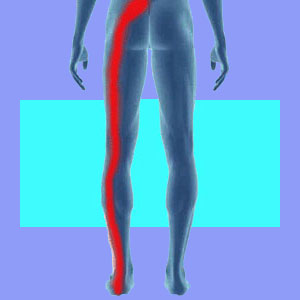
We converse with many people who are searching for an easy to understand sciatica definition on our various websites, which tells us that a great number of patients with back and leg pain do not even truly understand what sciatica is and whether or not their symptoms qualify to be called sciatic nerve pain or not.
The goal of this article is to clarify the definition of sciatica so that all patients can know whether they are suffering from a true sciatica syndrome or whether they are being victimized by another problematic health issue. This informational essay will also help diagnosed patients to better understand the full nature and extent of their condition, providing them topics for discussion with their respective doctors and other care providers.
Sciatica Definition Provided
Sciatica is defined as a lower body pain syndrome enacted by a true structural spinal source, such as a herniated disc, spinal osteophyte complex, spinal curvature issue or vertebral misalignment issue. True sciatica does not include various non-spinal sources of leg symptoms including peripheral neuropathy, sacroiliac joint concerns and soft tissue pathologies, such as piriformis syndrome. These non-spinal sources and contributors qualify to be called pseudo-sciatica, since the symptoms may be identical, but the underlying process does not exist in the vertebral column.
The symptoms of sciatica can vary greatly, with lower back, buttocks and leg pain being the most common, often accompanied by tingling, weakness and/or numbness in one or more areas of the buttocks, hips, legs or feet. Some patients have widespread and variable symptomatic patterns, while others are narrower and more specific.
Sciatica Definition Questions
Once people know what sciatica is, they usually begin to wonder what causes sciatica. This is one of the most difficult answers to provide, since there are so many possibilities which can explain true and pseudo-sciatica. Unfortunately, many seemingly verified sciatica diagnoses turn out to be incorrect with the test of time.
Statistics clearly show that there is little, if any, correlation between most mild to moderate structural spinal issues and the incidence of back pain. This holds true for sciatica, as well. A great number of patients have sciatica with no structural reason supporting the symptoms. Just as many have severe structural spinal issues, yet no pain at all.
A considerable sample of patients have spinal issues and possibly coincidental sciatica. In some cases, these issues may be wholly causative or partially contributory to the symptoms. In other cases, these spinal issues may be innocent as the source of sciatica.
The true reason for pain may be another anatomical concern outside of the spine or may be non-structural, such as in the epidemic number of ischemic sciatica cases.
Sciatica Clearly Defined
Hopefully, this page will help to clarify the term sciatica and how it is defined by medical science. If not, then you should take some time to research this website further, since everything you ever wanted to know about the condition, including the most effectual sciatica treatment options, is all right here. It is my goal to help you to overcome your pain through knowledge.
My first piece of advice to get you on the right path to relief is to become involved in your own care and learn all you can about your diagnosed condition.
I have implemented a site search function which will allow you to find any term used on the entire Cure Back Pain Network of sites simply and easily. This is located towards the bottom of the right column. Additionally, if you can not find the answer to your questions here, at least make notes for yourself which can be discussed with your doctor the next time you meet with them. A learned patient is already halfway to a cure.




